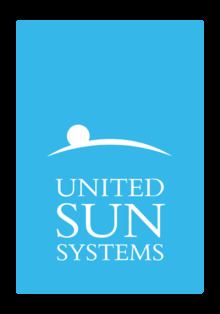Area served Worldwide Founder Lars Valentin Jacobsson Type of business Ltd. | Products CSP Dish-Stirling Founded 2010 | |
 | ||
Industry Energy development
Renewable energy
Solar electricity
Concentrated solar power
Electricity
CHP (Combined heat and power) Key people Joachim Hjerpe (CEO) and Director
Lars Valentin Jacobsson (Executive Chairman) Headquarters London, United Kingdom, United Kingdom | ||
United Sun Systems International Ltd is an established British limited company with large parts of its operation including technical development based in Sweden. The company works in the solar and renewable energy market. It has developed a dish-Stirling system capable of delivering up to 33 kW for remote, end of the line and utility scale electricity production.
Contents
Overview
United Sun Systems is a solar and renewable energy technology company. Its main focus is developing a concentrated solar power dish-Stirling system for electricity production. Dish-Stirling is one of the available applications of concentrated solar power (CSP). This type of solar energy technology uses mirrors or lenses to concentrate a large area of sunlight, or solar thermal energy, onto a focal point which in turn creates extensive heat which then drives a heat engine (Stirling engine) connected to an electric power generator.
The dish-Stirling principle has been researched and tested by organisations such as Sandia National Laboratory, NREL, Plataforma Solar de Almeria and Schlaich Bergermann & Partner.
United Sun Systems International Ltd has a 100% owned Swedish based subsidiary called Stirling Gas AB. This subsidiary will utilise the Stirling engine for the CHP (combined heat and power) market.
History
Utilising the Stirling engine in a solar application was pioneered by Swedish American inventor John Ericsson in the 1870s.
This V4-90 Stirling engine, was acquired by United Sun Systems in 2010. This engine was the result of the Automotive Stirling Engine Development Program, funded by the Department of Energy (DoE) and administrated by NASA-LeRC (NASA Lewis Research Centre), now renamed to NASA Glenn Research Centre. Other partners and participants in the project were Mechanical Technology Incorporated, Ford Motor Company, United Stirling AB and AM General (owned by AMC – American Motors Corporation, where United Stirling AB had a key role in the Stirling engine development and evolution).
An earlier version of the V4-90, the V4-X36 engine was used to set the world record for the fastest ever Stirling engine-powered car. The record was set at the racing track of Hällered (Volvo Hällered Test Facility) near Borås, in Sweden and clocked at 135.88 km/h. The V4-X36 was mounted in a modified Porsche Bergspyder racing car.
After the bankruptcy of the American company Stirling Energy Systems in 2012, United Sun Systems bought the Stirling Energy Systems Maricopa solar plant in Phoenix, Arizona, in a joint venture with a Chinese/American corporation.
The company started out as United Sun Systems Ltd. This company is today one of the major shareholders of United Sun Systems International Ltd.
Technology
A dish-Stirling System consists of a parabolic reflector that concentrates the sunlight onto a solar receiver. Inside the receiver the temperature rises to 800 degrees Celsius, and the heat starts the Stirling engine by making the working gas inside the engine expand. The crankshaft in the engine turns with 1,400 rpm per minute. Connected to a generator, the system creates 25 to 33 kWh electricity during solar hours.
United Sun Systems is using a V-shaped Stirling engine which, like the one used by Stirling Energy Systems, originates from United Stirling AB, a subsidiary of Swedish submarine manufacturer Kockums Naval Solutions, now Saab Group.
United Sun Systems has developed a dish-Stirling System capable of delivering up to 33 kW for remote, end of the line and utility scale electricity production. Using a 14-meter diameter parabolic reflector, and the solar-to-grid system conversion efficiency rate of 30% that is attributed to dish-Stirling, the system is expected to, when in high scale manufacturing volume (1,000 USD/kW), achieve a cost of just below 0.02 USD per kWh.
In order to further increase the efficiency of the technology, United Sun Systems is working on a hybrid system that will be able to power the Stirling engine with a separate heat source during non-solar hours, thus creating a 24-7 electricity generating system. United Sun Systems is also developing energy storage.
